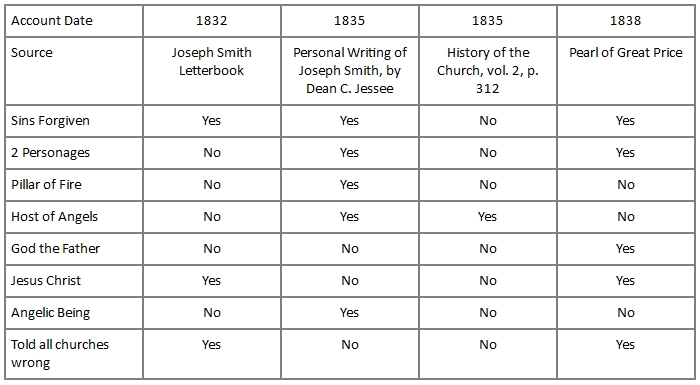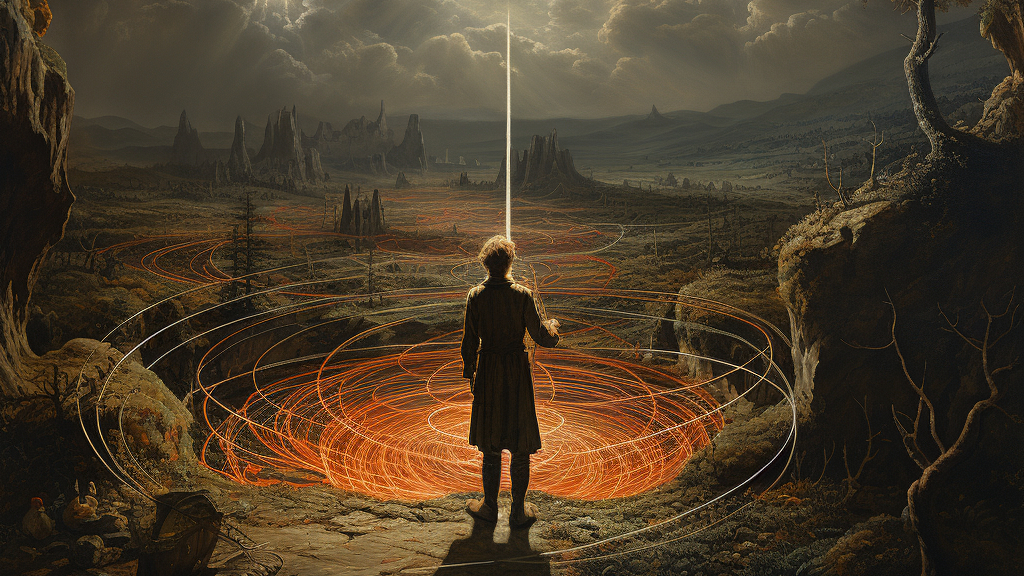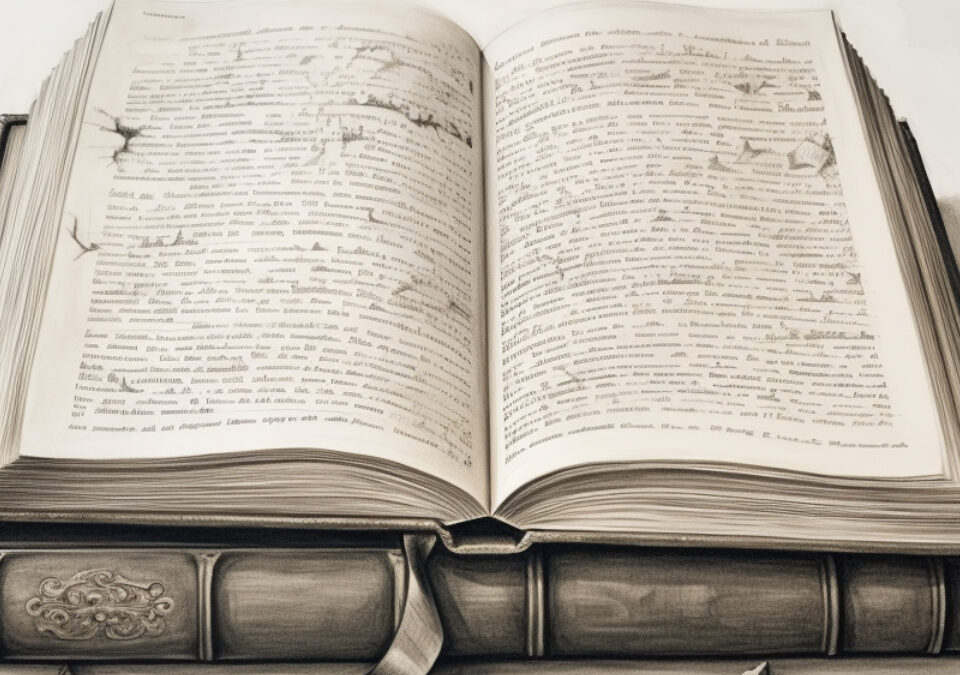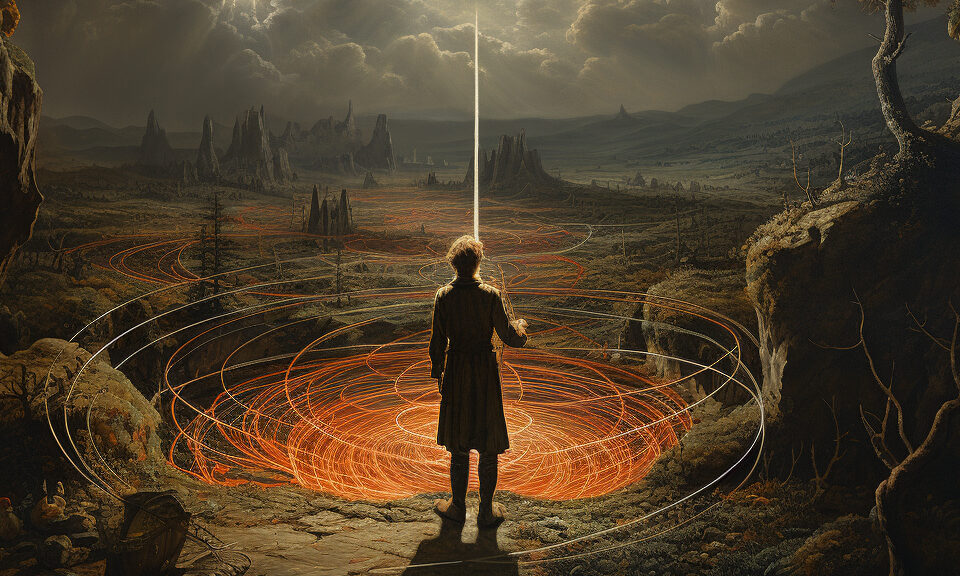
1. Polygamy Pre-Dates Revelation
October 2, 2024
3. Questions on the Lost 116 Pages
October 6, 2024Facts on the First Vision
Table of contents
- Facts on the First Vision
- A1) There was no mention of the First Vision in any church publication until 1840, a full twenty years after it happened and 11 years after the church was officially founded.
- A2) Joseph Fielding Smith was in possession of the 1832 First Vision account sometime in the 1930s or 1940s and kept it suppressed from the general knowledge of the Church. It was torn out of the letterbook it was written in.
- A3) In Joseph’s hand written 1832 First Vision account there is no mention of seeing God, but says he saw Jesus alone.
- A4) In the 1835 Account Joseph’s motives for going to God change and there is no mention that either Jesus or God appear. Now there are angels and his tongue was bound by Satan.
- A5) The account used by the LDS church today, the 1838 account, was written at a time Joseph Smith was dealing with a credibility crisis in the church.
- A6) Arguments are frequently made that Joseph Smith embellished his story of the first vision over time.
- A7) Joseph’s accounts resemble other vision accounts of that day.
- Issues these Facts Raise
- Questions these Facts Raise
A1) There was no mention of the First Vision in any church publication until 1840, a full twenty years after it happened and 11 years after the church was officially founded.
Supporting Sources and Quotes
“Orson Pratt of the Quorum of the Twelve Apostles authored the earliest published account of Joseph’s First Vision of Deity in this pamphlet in Edinburgh, Scotland, in 1840.”
-LDS website, Orson Pratt Pamphlet (1840).
“The fact that none of the available contemporary writings about Joseph Smith in the 1830's, none of the publications of the Church in that decade, and no contemporary journal or correspondence yet discovered mentions the story of the first vision is convincing evidence that at best it received only limited circulation in those early days.”
And Later, “As far as Mormon literature is concerned, there was apparently no reference to Joseph Smith's first vision in any published material in the 1830's. Joseph Smith's history, which was begun in 1838, was not published until it ran serially in the Times and Seasons in 1842. The famous "Wentworth Letter," which contained a much less detailed account of the vision, appeared March 1, 1842…”
- James B. Allen, Former Assistant Church Historian, “The Significance of Joseph Smith’s ‘First Vision’ in Mormon Thought,” 29–45.
A2) Joseph Fielding Smith was in possession of the 1832 First Vision account sometime in the 1930s or 1940s and kept it suppressed from the general knowledge of the Church. It was torn out of the letterbook it was written in.
Supporting Sources and Quotes
“Joseph Smith published two accounts of the First Vision during his lifetime. The first of these, known today as Joseph Smith—History, was canonized in the Pearl of Great Price and thus became the best known account. The two unpublished accounts, recorded in Joseph Smith’s earliest autobiography and a later journal, were generally forgotten until historians working for The Church of Jesus Christ of Latter-day Saints rediscovered and published them in the 1960s.”
-LDS.org, First Visions Accounts essay.
David Note: This is the second paragraph in the First Vision Accounts essay, and it is misleading with the facts. Joseph Fielding Smith, or someone he knew, tore out the page where Joseph had written the 1832 First Vision Account and kept it locked up in his vault. Later in the 1960s word was leaked out that another first vision account existed, and anti-Mormon Sandra and Jerald Tanner began to ask for a copy of the account. When it became clear it couldn’t be suppressed any longer, the church quietly gave the account to a BYU student to write a paper about, and then taped the pages back in the letterbook. The tape marks are still visible on the Joseph Smith Papers project website. Of course, this leads to the question why rip out and lock away the only Joseph Smith handwritten, and earliest version, of the first vision?
From Joseph Smith Papers Website: JS History, ca. Summer 1832, pp. 1–3. “This is the earliest and most personal account, and the only one that includes Joseph Smith’s own handwriting.”
A. Removing the First Vision account discussed at Joseph Smith Papers project website: “Photocopy and microfilm images of the book, as well as an inspection of the conservation work now present in the volume, indicate that the text block separated from the binding at some point. Also, the initial three leaves containing the history were excised from the volume. The eight inscribed leaves in the back of the volume may have been cut out at the same time. Manuscript evidence suggests that these excisions took place in the mid-twentieth century. A tear on the third leaf, which evidently occurred during its excision, was probably mended at the time. This tear was mended with clear cellophane tape, which was invented in 1930. The three leaves of the history certainly had been removed by 1965, when they were described as “cut out,” although they were archived together with the letterbook. The size and paper stock of the three excised leaves match those of the other leaves in the book. Also, the cut and tear marks, as well as the inscriptions in the gutters of the three excised leaves, match those of the remaining leaf stubs, confirming their original location in the book. The three leaves were later restored to the volume, apparently in the 1990s. This restoration was probably part of a larger conservation effort that took place, in which the entire volume was rebound, including binding the formerly loose index of letters. The first gathering, which contains the history, was slightly trimmed in connection with this conservation work. The volume shows marked browning, brittleness, and wear. It is listed in Nauvoo, Illinois, and early Salt Lake City, Utah, inventories made by the Church Historian’s Office, as well as in the 1973 register of the JS Collection, indicating continuous institutional custody.”
A3) In Joseph’s hand written 1832 First Vision account there is no mention of seeing God, but says he saw Jesus alone.
Supporting Sources and Quotes
Note: Other early LDS church teachings (and Joseph Smith teachings) at that time also seemed to indicate a trinitarian view, and not three distinct personages as seen in these examples:
Evening & Morning Star, July 1832: Now what things can there be of greater moment and importance for men to know, or God to reveal, than the nature of God and ourselves the state and condition of our souls, the only way to avoid eternal misery and enjoy everlasting bliss!
The Scriptures discover not only matters of importance, but of the greatest depth and mysteriousness. There are many wonderful things in the law of God, things we may admire, but are never able to comprehend. Such are the eternal purposes and decrees of God, the doctrine of the Trinity, the incarnation of the Son of God, and the manner of the operation of the Spirit of God upon the souls of men, which are all things of great weight and moment for us to understand and believe that they are, and yet may be unsearchable to our reason, as to the particular manner of them.
Luke 10:22 (King James Bible): “All things are delivered to me of my Father: and no man knoweth who the Son is, but the Father; and who the Father is, but the Son, and he to whom the Son will reveal him.”
Luke 10:22 (Joseph Smith Translation): “All things are delivered to me of my Father: and no man knoweth that the Son is the Father, and the Father is the Son, but him to whom the Son will reveal it.”
Ether 3:14 (Book of Mormon): "I am the father and the son"
The statement from the three witnesses: And the honor be to the Father, and to the Son, and to the Holy Ghost, which is one God.
The title page of the Book of Mormon: And also to the convincing of the Jew and Gentile that Jesus is the Christ, the Eternal God, manifesting himself unto all nations
The book of First Nephi in the Book of Mormon itself changes from a trinitarian view (original 1830 version) to a plurality of Gods (1837 version):
1830: Behold, the virgin whom thou seest is the mother of God
Now: Behold, the virgin whom thou seest is the mother of the Son of God (11:18)
1830: Behold, the Lamb of God, yea, even the Eternal Father!
Now: Behold, the Lamb of God, yea, even the Son of the Eternal Father! (11:21)
1830: yea, the everlasting God was judged of the world
Now: yea, the Son of the everlasting God was judged of the world (11:32)
1830: …the Lamb of God is the Eternal Father…
Now: …the Lamb of God is the Son of the Eternal Father… (13:40)
Read the 1832 account on the Joseph Smith Paper Project website here.
A4) In the 1835 Account Joseph’s motives for going to God change and there is no mention that either Jesus or God appear. Now there are angels and his tongue was bound by Satan.
Supporting Sources and Quotes
A5) The account used by the LDS church today, the 1838 account, was written at a time Joseph Smith was dealing with a credibility crisis in the church.
Supporting Sources and Quotes
Two of the three witnesses leave in 1838: Oliver Cowdery was excommunicated in April and David Whitmer says in June that God spoke to him to tell him to leave the church: "If you believe my testimony to the Book of Mormon; if you believe that God spake to us three witnesses by his own voice, then I tell you that in June, 1838, God spake to me again by his own voice from the heavens, and told me to separate myself from among the Latter-day Saints, for as they sought to do unto me, so should it be done unto them." (From “An Address to All Believers in Christ” by David Whitmer, Trascript available online here:https://en.wikisource.org/wiki/An_Address_to_All_Believers_in_Christ)
David Whitmer in particular believed that Joseph Smith was a fallen prophet because the revelations he was claiming were not received using the seer stone, and went against earlier teachings. Whitmer said in his Address: "[W]hen the Book of Commandments was printed, Joseph and the church received it as being printed correctly. This I know. In the winter of 1834 they saw that some of the revelations in the Book of Commandments had to be changed, because the heads of the church had gone too far, and had done things in which they had already gone ahead of some of the former revelations. So the book of Doctrine and Covenants was printed in 1835, and some of the revelations changed and added to."
Whitmer: "I see that some of you claim that the same power which gave these revelations, had authority to change them, and refer to Jer. xxxvi:32. By reading this passage you will see that the words which were added were “like words;” words which conveyed the same meaning — were added to that book by Jeremiah when he was writing it over again, because it had been burned in the fire by the king. But the words added to the two former revelations are not “like words,” as they change and reverse the original meaning."
Also losing Joseph credibility was that in 1837 the Kirtland Safety Society bank collapsed, losing many members all of their money and possessions. This left many angry and shaken with their belief in Joseph as a prophet.
A6) Arguments are frequently made that Joseph Smith embellished his story of the first vision over time.
Supporting Sources and Quotes
As the LDS.org, First Visions Accounts essay puts in: “Embellishment. The second argument frequently made regarding the accounts of Joseph Smith’s First Vision is that he embellished his story over time. This argument focuses on two details: the number and identity of the heavenly beings Joseph Smith stated that he saw. Joseph’s First Vision accounts describe the heavenly beings with greater detail over time. The 1832 account says, “The Lord opened the heavens upon me and I saw the Lord.” His 1838 account states, “I saw two Personages,” one of whom introduced the other as “My Beloved Son.” As a result, critics have argued that Joseph Smith started out reporting to have seen one being—“the Lord”—and ended up claiming to have seen both the Father and the Son.”
The central crux of the story is God and Christ appearing to Joseph Smith. This is a significant detail and not one that would be easily forgotten. However, each of the retelling appear to correspond with the theology at the time (which evolved) and personal struggles Joseph was having at the time.
Further examples of differences between versions of the First Vision:

A7) Joseph’s accounts resemble other vision accounts of that day.
LDS historian Richard Bushman has identified over 33 visionary tales published between 1783 and 1815. The Visionary World of Joseph Smith [7MB PDF]
Examples of similarities:
| Norris Stearns (1815) | Joseph Smith (1842) | |
| Both near the brink of death | as I lay apparently upon the brink of eternal woe, seeing nothing but death before me, suddenly | at the very moment when I was ready to sink into despair and abandon myself to destruction |
| Both are interrupted by a light | there appeared a small gleam of light in the room above the brightness of the sun | I saw a pillar of light exactly over my head above the brightness of the sun |
| Both see the Father and the Son in bodily form | I saw two spirits... One was God my maker, almost in bodily shape like a man... below him stood Jesus Christ my Redeemer, in perfect shape like a man... | I saw two personages... standing above me in the air. One of them spake unto me, calling me by name and said, pointing to the other - This is My Beloved Son. Hear Him! |
| Both are unable to describe the appearance | I could not describe their glory | whose brightness and glory defy all description |
| Both use "pillar" in their descriptions | a Pillar and a Cloud | a pillar of light |
| Elias Smith (1816) | Joseph Smith (1842) | |
| Both enter the woods in the morning | I went into the woods one morning | I retired to the woods to make the attempt. It was on the morning of a beautiful, clear day |
| Both see a light | a light appeared to shine from heaven | I saw a pillar of light exactly over my head |
| Both have a divine encounter | My mind seemed to rise in that light to the throne of God and the Lamb, and while thus gloriously led... And I looked, and, lo, a Lamb stood on the mount Sion | When the light rested on me I saw two Personages, whose brightness and glory defy all description |
| Charles G. Finney (1821) | Joseph Smith (1842) | |
| Both are impressed with scripture | Just at that point this passage of Scripture seemed to drop into my mind with a flood of light...I instantly seized hold of this with my heart | Never did any passage of scripture come with more power to the heart of man than this did at this time to mine. It seemed to enter with great force into every feeling of my heart |
| Both enter the woods to be alone to pray | I turned and bent my course toward the woods, feeling that I must be alone, and away from all human eyes and ears, so that I could pour out my prayers to God...I crept into this place and knelt down for prayer | I retired to the woods to make the attempt... having looked around me, and finding myself alone, I kneeled down and began to offer up the desires of my heart to God |
| Both struggle to pray | But when I attempted to pray I found that my heart would not pray... But lo! when I came to try, I was dumb; that is, I had nothing to say to God; or at least I could say but a few words | It was the first time in my life that I had made such an attempt, for amidst all my anxieties I had never as yet made the attempt to pray vocally... I was seized upon by some power which entirely overcame me, and had such an astonishing influence over me as to bind my tongue so I could not speak |
| Both overwhelmed by power | An overwhelming sense of my wickedness in being ashamed to have a human being see me on my knees before God, took such powerful possession of me | When immediately I was seized upon by some power which entirely overcame me, and had such an astonishing influence over me |
| Both fall into despair | Finally I found myself verging fast to despair | at the very moment when I was ready to sink into despair |
| Both experience weakness | I felt almost too weak to stand upon my knees | I had no strength; but soon recovering some degree |
| Asa Wild (1823) | Joseph Smith (1842) | |
| Both have a divine encounter | realizing in a remarkable manner the majesty, greatness and glory, of that Being | I saw two Personages, whose brightness and glory defy all description |
| Both lose capacity | It seemed as if my mind, though active in its very nature, had lost all its activity, and was struck motionless, as well as into nothing | When immediately I was seized upon by some power which entirely overcame me, and had such an astonishing influence over me as to bind my tongue so that I could not speak |
| Both are told all denominations are corrupt | He also told me, that every denomination of professing christians had become extremely corrupt | the Personages who addressed me said that all their creeds were an abomination in his sight; that those professors were all corrupt |
| Both withold additional information | and many other things did he say unto me, which I cannot write at this time | Much more the Lord revealed, but forbids my relating it in this way |
Issues these Facts Raise
“Our whole strength rests on the validity of that vision. It either occurred or it did not occur. If it did not, then this work is a fraud. If it’s true, it’s the most important thing in the world. Now, that’s the whole picture. It is either right or wrong, true or false, fraudulent or true.”
- Gordon B. Hinckley, The Marvelous Foundation of Our Faith, October 2002.
Questions these Facts Raise
Why wasn't the First Vision mentioned in any church publication until 1840, twenty years after it happened and 11 years after the church was officially founded? Why did Joseph wait so long to publish these accounts? Why doesn't the First Vision play an important role in Mormon history until the 1880s? It was scarcely mentioned before then but now is considered to be the most important event in almost 2,000 years.
Why did Joseph only mention one person visiting him when he first wrote his account in 1832? This is the defining aspect the church emphasized and what sets Mormonism apart from Trinitarian churches.
Why did church leaders keep information about the other contradictory accounts (1832 and 1835) from members and investigators for over a century? Why cut out that original 1832 account out of Joseph’s personal journal with a penknife and store it away in a church vault in the church historian’s office?
Why did Joseph only mention one person visiting him when he first wrote his account in 1832? Does this align with other early LDS teachings that seemed to indicate a trinitarian view? Why does it appear that Joseph’s beliefs about the godhead began as Trinitarian and then shifted throughout his life? (see original Book of Mormon and Lectures on Faith, Lecture 5) This doesn’t make sense if he actually saw God and Jesus. Why would Joseph Smith ever teach a Trinitarian view of God if he has seen both God and Jesus in person? For example, Lectures on Faith, Lecture 5, “They are the Father and the Son: the Father being a personage of spirit, glory, and power, possessing all perfection and fulness. The Son, who was in the bosom of the Father, is a personage of tabernacle”
Does it make sense that Smith would remember more precise details many more years later than the original version?
Why do the versions change to match a theology that appears to be changing? This is consistent with other revelations that changed over time as well, such as the Book of Mormon and revelations in Doctrine and Covenants.
How did the credibility crisis in the church, marked by the departure of two of the three witnesses in 1838, influence the writing of the 1838 First Vision account?
What are the arguments surrounding the claim that Joseph Smith embellished the First Vision story over time, and how does the evolving theology and personal struggles of Joseph Smith at the time play a role in this? Seems like some details would be lost or misremembered, but I’d still expect Joseph Smith to know whether there were God and Jesus there or just Jesus. Why have variations between major aspects in the different accounts? How can we conceive that that Prophet wouldn’t even remember how many people were at the vision?
How do the similarities between Joseph Smith's First Vision accounts and other vision accounts of that time, as identified by LDS historian Richard Bushman, impact my understanding of the authenticity of the First Vision?



